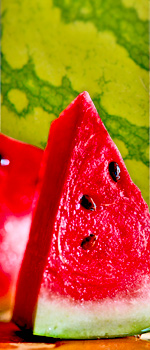 |
Khai McBride Certified Mortgage Planner Skyline Financial Corp. Phone: 800.399.6890 Fax: 800.399.6891 khai@mcbridegroup.com www.mcbridegroup.com |
 | ||
| ||||
June 2007

|
Grilling Steaks: A Step-By-Step Guide to Achieving Barbecue Prowess By Kirk Leins
I have to be honest about something. When my editors initially asked me to write an article on grilling steaks, I was slightly hesitant to say yes. My apprehension at the time had nothing to do with my opinion on the subject. It did, however, have a lot to do with one question that kept running through my mind. Where do I begin? Lucky for all of us, I've managed to organize my thoughts on the topic. In doing so, I've attempted to lay out a comprehensive, yet digestible dossier on steaks and the practice of grilling them outdoors. But, before we go any further, I'd like to share with you a little steak-grilling philosophy. Like everything else in this world, there are upsides and downsides to grilling steaks outdoors, whether it's over charcoal, wood, or an open flame. Let's start with the positives. The primary reason to grill outdoors is flavor, especially when using either charcoal or wood as your fuel of choice. The smoke they create permeates anything sitting atop the grill, giving your food a quality that cannot be described with words. But steaks also taste great when they're cooked on a gas grill. This is due in large part to the flavor that's created when the heat of the flame comes into contact with the flavor left behind on the grill from previous grilling sessions. Outdoor grills also make it much easier to prepare a steak dinner for a large group. They not only handle a bigger payload, but they also simplify the impending clean up. In terms of the not-so-positive, it really comes down to two points for me. First, there are some steaks that arguably do better in a pan than on a grill, filet mignon and hangar steak to name two. The point here is that much of your grilling success has to do with the type of steak you choose. We'll get to some of my favorite cuts in a bit. The second downside has to do with the temperamental nature of the grill. As opposed to the predictability of cooking in a pan on top of your stove, an outdoor grill involves many "X factors". Everything – from your choice of fuel to hot spots on the grill – will have an effect on how your meat cooks. And when you're attempting to cook a steak to a specific degree of doneness, nothing wreaks more havoc on the final outcome than these types of variables. I'll show you how to deal with some of them later in this article. Where to Buy Another location for procuring really good steak is at one of your community's higher-end grocery stores. These stores are sometimes privately owned, but can also be part of a small chain. They typically offer outstanding produce, full-service bakeries and delis, harder-to-find grocery items, and top-notch meat and fish counters. The only problem is that you generally pay for this convenience in the form of higher prices throughout the store. A more cost-effective way to purchase steak is from a warehouse store like Costco. You may be forced into purchasing 4 to 6 steaks at a time, but the quality of the meat is typically very good, and the savings are awesome. This is a great choice if you're entertaining a large group or if you have room in the freezer to stock any unused steaks. Another cost-effective way to buy steaks involves your computer. Thanks to modern technology, there are countless online meat purveyors ready to ship great steaks right to your front door. One such website is www.omahasteaks.com. By logging on to their website, you'll be inundated with countless options as well as some really good deals. Two other websites I really like are www.lobels.com and www.nimanranch.com. With both companies, the quality of the steak is top-notch. The prices, however, are higher than those found at Omaha Steaks. What to Buy In terms of cuts of steak that are good for the grill, you have several choices. Two that come to mind instantly are T-bone and Porterhouse steaks. T-bone steaks are made up of two cuts, filet and New York strip, set apart by a bone resembling the shape of the letter T. This bone, along with an ample amount of fat, keeps both cuts juicy and tender, even when cooking over the high heat of an outdoor grill. FYI Porterhouse steaks are nothing more than T-bone steaks with larger portions of both filet and strip. Probably my favorite steak to cook on the grill is a cut known as the Rib Eye. Taken from the small end of the rib roast, the Rib Eye is as juicy and flavorful as beef can be. Traditional Rib Eyes are boneless, but they can also be found with the bone still attached. This version is known as a Cowboy Steak. A USDA Prime Rib Eye steak is not cheap, but trust me when I say that you cannot go wrong when cooking one. Whether you're using a cast iron pan or your outdoor grill, it's very hard to dry out this steak, no matter what degree of doneness you're trying to achieve. It is as forgiving as a steak can be. The New York Strip is also a nice cut for the grill as its outside edge is lined end-to-end with roughly 1/3 inch of fat. This strip of fat not only adds flavor to the steak but also keeps its edge very juicy. The problem with New York Strips is that they have a tendency to dry out the farther you get away from that fat. That's why I always suggest going with a New York Strip that's no thinner than 1 1/4 inches. The added thickness allows you the ability to get a nice char on the outside of the steak without over cooking the inside. If you're looking for a tender and flavorful cut of steak that is also budget friendly, look no further than Skirt Steak. If you read last month's article on preparing Fajitas for Cinco de Mayo, you're well aware of my love of good Skirt Steak. Not only is Skirt economical, it is unbelievably tasty and juicy, not to mention highly versatile. How to Cook Your Steak
Now that you've got the skinny on what it takes to make a great steak, it's time to show you one of my favorite preparations. Grilled Rib Eye Steaks with Blue Cheese Butter (Serves 2) In a bowl, use a fork to mix butter and blue cheese until fully combined. Place the butter mixture on top of a sheet of plastic wrap. Using your hands, form the butter into the shape of a small log, 1 1/2 inches in diameter. Wrap tightly in plastic wrap, and set in the fridge for 2 hours. Heat your outdoor grill. Meanwhile, lightly brush each side of both steaks with a small amount of olive oil. This allows for better contact between the steak and the grill. Season all sides liberally with salt and pepper, and set aside on a plate. Once your grill is ready for cooking, place steaks on a very hot part of the grill and cook for approximately 8 minutes (four minutes per side) for medium-rare. Remove steaks to a plate. Unwrap blue cheese butter, and cut off four, 1/4-inch slices. Top each steak with two slices of blue cheese butter and serve. This is an awesome steak as the combination of beef and blue cheese is a perfect one. Serve this Rib Eye with roasted potatoes, mixed greens with balsamic vinaigrette, and a great glass of red wine. Bon Appétit and happy grilling!
| ||||||||||||||||||||||||||||||
You are receiving a complimentary subscription to YOU Magazine as a result of your ongoing business relationship with Khai McBride. While beneficial to a wide audience, this information is also commercial in nature and it may contain advertising materials. INVITE A FRIEND to receive YOU Magazine. Please feel free to invite your friends and colleagues to subscribe. SUBSCRIBE to YOU Magazine. If you received this message from a friend, you can subscribe online. UNSUBSCRIBE: If you would like to stop receiving emails from Khai McBride, you can easily unsubscribe. Skyline Financial Corp. |
26840 Agoura Road Calabasas, CA 91301 Powered by Platinum Marketing © Copyright 2025. Vantage Production, LLC. | |||||||||



 Kirk Leins has been cooking his entire life. No stranger to professional kitchens, he currently devotes most of his time to cooking instruction, food writing, and producing television. Kirk also provides his services as a personal chef in and around the Los Angeles area. He has made several TV appearances on both the national and local level, and is the Executive Chef for YOU Magazine. His free newsletter, The Everyday Gourmet, is available by contacting Kirk at
Kirk Leins has been cooking his entire life. No stranger to professional kitchens, he currently devotes most of his time to cooking instruction, food writing, and producing television. Kirk also provides his services as a personal chef in and around the Los Angeles area. He has made several TV appearances on both the national and local level, and is the Executive Chef for YOU Magazine. His free newsletter, The Everyday Gourmet, is available by contacting Kirk at